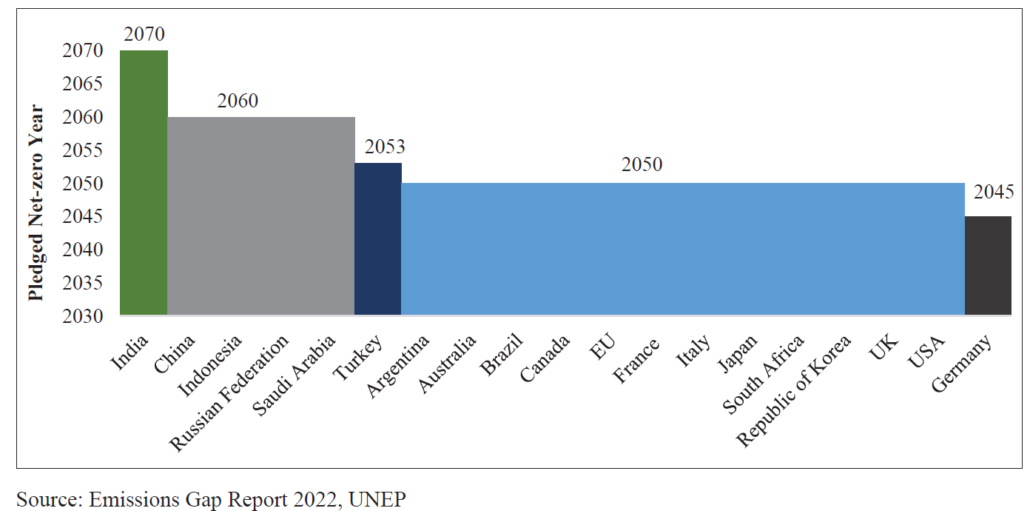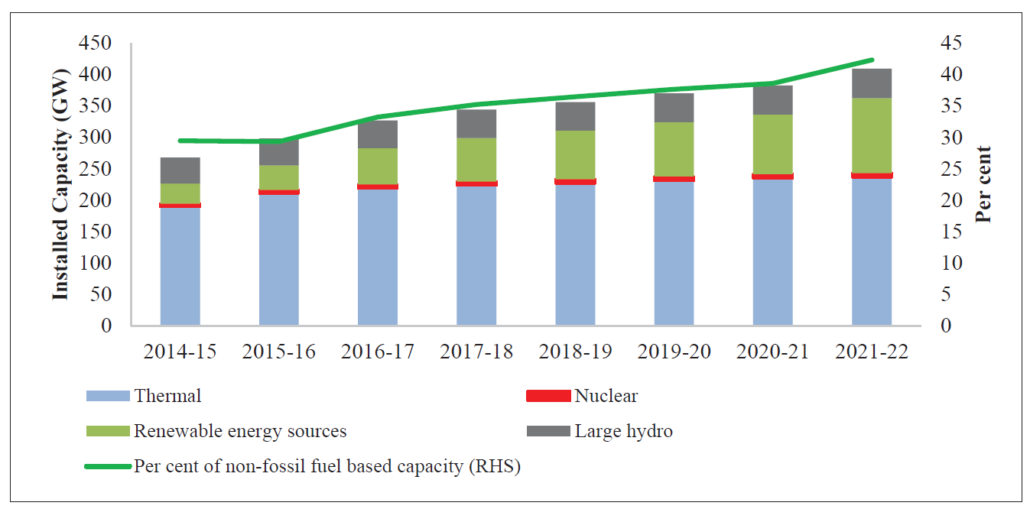India’s “green growth”: is the green skin-deep?
– Payal Agarwal, Deputy Manager | corplaw@vinodkothari.com
Talking about green growth may seem like rhetoric. From policy-makers to economists, from corporate governance experts to environmentalists, everyone seems to be having “green growth” on the top of the agenda.
The Economic Survey dedicated a full chapter to climate change and related issues. The Budget also has green growth as one of the seven saptarishis, to guide the FM’s plans for our financial future.
Need of the hour
India has been taking small steps towards reaching its commitment to the net-zero emissions goal by 2070, as compared to a majority of countries committing to reach the net-zero targets by 2050. While the country contributes to a very low percentage of global emissions (only 4% of the cumulative global emissions from the period 1850-2019[1]), the global nature of the problem of climate change is what makes the country equally vulnerable to the problem, if not more. Further, given its long coastline, monsoon-dependent agriculture, and large agrarian economy, India is considered to be one of the most vulnerable countries to the climate change issue[2].

Figure 1: Net Zero pledges of countries
Keeping up with the shift towards green as noticed in the previous Union Budget, the Union Budget 2023-24 also focuses on ‘Green Growth’ as one of the seven priorities of the present Budget. In the words of the FM, “India is moving forward firmly for the ‘panchamrit’ and net-zero carbon emission by 2070 to usher in green industrial and economic transition. This Budget builds on our focus on green growth.” The components of ‘Green Growth’ as announced in the Budget are aligned with the Nationally Determined Contribution (NDC) targets of the country.
Components of ‘green growth’
The various components of ‘Green Growth’, as proposed by the Finance Minister include –
Green Energy and Mobility
Achievement of about 50 percent cumulative electric power installed capacity from non-fossil fuel-based energy resources by 2030, is one of the updated NDCs of India. Therefore, various proposed and ongoing initiatives contribute towards creating cleaner sources of energy and meeting the net zero objectives of the country. Huge outlays have been devoted to priority capital investments towards energy transition and net zero objectives (Rs. 35,000 crores), renewable energy evacuation (Rs. 20,700 crores), biogas plants under GOBARdhan (Galvanizing Organic Bio-Agro Resources Dhan) (Rs. 10,000 crores) and development of green hydrogen ecosystem under the National Green Hydrogen Mission (Rs. 19,700 crores). Coastal shipping will also be promoted as an energy efficient as well as cost-efficient mode of transport.
Data reveal an increasing trend in the total non-fossil fuel-based capacity in the electricity generation capacity of the country –

Figure 2: Share of non-fossil fuel based capacity within the overall electricity generation capacity
A measure closely related towards clean transportation and reducing pollution remains the scrapping of old polluting vehicles, for which funds have been allocated by the Central Govt.
Tax exemptions on green mobility
Promoting the concept of green mobility further, the Budget proposes to exempt excise duty on GST-paid compressed biogas. To this effect, w.e.f. 2nd February, 2023, central excise duty exemption is being provided to blended Compressed Natural Gas from so much of the amount as is equal to the GST paid on Bio Gas/Compressed Bio Gas contained in the blended CNG. Further, customs duty exemption is being extended to import of capital goods and machinery required for manufacture of lithium-ion cells for batteries used in electric vehicles.
Green farming and afforestation
Announcements have been made towards the launch of new initiatives towards promoting green farming. For instance, PM-PRANAM (PM Programme for Restoration, Awareness, Nourishment and Amelioration of Mother Earth) is proposed to be launched to incentivize the States and Union Territories to promote alternative fertilizers and balanced use of chemical fertilizers. Further, the Bhartiya Prakritik Kheti Bio-Input Resource Centres are proposed to be set up to facilitate adoption of natural farming as well as to create a national-level distributed micro-fertilizer and pesticide manufacturing network.
MISHTI (Mangrove Initiative for Shoreline Habitats & Tangible Incomes) is also proposed to be taken up for mangrove plantation along the coastline and on salt pan lands, wherever feasible. As per a recent study, certain mangrove species in Chilika and Sundarbans along the east coast and Dwarka and Porbandar along the west coast of India are likely to reduce and shift landward by 2070 due to a decline in suitable habitats in response to precipitation and sea level changes[3].
Amrit Dharohar for biodiversity
A move towards sustaining biodiversity, the government announces to promote the unique conservation values of the local communities through Amrit Dharohar, a scheme that will be implemented over the next three years to encourage optimal use of wetlands, and enhance biodiversity, carbon stock, eco-tourism opportunities and income generation for local communities.
The move is in furtherance to the 1992 Earth Summit held at Rio de Janeiro that led to the adoption of an internationally binding legal instrument, the Convention on Biological Diversity (CBD), with the objectives of conservation, sustainable use, and fair and equitable sharing of benefits arising from the use of biological diversity.
Green Credit Programme
While meeting the net zero targets is the responsibility of the country, the same can be achieved only through active participation of all sectors of the society, especially the corporate houses. The Budget proposes to incentivize environmentally sustainable and responsive actions by companies, individuals and local bodies, and help mobilize additional resources for such activities through the notification of “Green Credit Programme” under the Environment Protection Act, 1986.
Is it the same as ‘carbon credits’?
The Budget does not provide any insight on what the Green Credit Programme will be, how the same will incentivise the environmental responsive actions, or who would be the beneficiaries. The nomenclature as well as the objective of the Programme indicates a sense of similarity with that of the carbon credits[4], that are soon to be introduced in the regulatory framework by way of amendments to the Energy Conservation Act, 2001[5], vide the Energy Conservation (Amendment) Bill, 2022 passed by the Parliament.
In our understanding, as opposed to the carbon credits scheme under the energy conservation laws whose access will be presumably limited to the energy-intensive sectors, the Green Credit Programme is supposed to be accessible to a larger group of participants. Further, while the carbon credits are restricted to the trading of the ‘carbon di-oxide emissions’ saved, the Green Credit Programme may include other elements such as particulate matter, fossil fuels usage etc.
How much does the Budget meet the ‘green’ targets?
In the COP 27 to the UNFCCC held in Egypt, India participated with a focus on mainstreaming the theme of LiFE – Lifestyle for Environment. The cover decision of COP 27, titled the Sharm el-Sheikh Implementation Plan, notes the ‘importance of the transition to sustainable lifestyles and sustainable patterns of consumption and production for efforts to address climate change’. Other decisions were setting up the Just Transition and Mitigation Work Program and the agreement on Joint work on the implementation of climate action on agriculture and food security to be conducted over four years.
However, coming to the present Budget, the “green” budget of the country is primarily around green energy only, with certain proposals aimed towards farming or biodiversity etc. The Budget does not contain much on facilitating transition finance and attracting private investments towards the ‘green’ mission. Obligations on climate should be matched with the on-time availability of climate finance, technology, and inputs like critical minerals, while not jeopardizing the socio-economic development objectives and aspirations[6].
[1] Refer Economic Survey 2022-23 – Pg 216
[2] Refer Economic Survey 2022-23 – Pg 220
[3] Pujarini Samal, Jyoti Srivastava, S.R. Singarasubramanian, Pooja Nitin Saraf, Bipin Charles, Ensemble modeling approach to predict the past and future climate suitability for two mangrove species along the coastal wetlands of peninsular India, Ecological Informatics, Volume 72, 2022.
https://doi.org/10.1016/j.ecoinf.2022.101819
[4] Read more about carbon credits – trading and markets at https://vinodkothari.com/2022/08/laying-the-framework-for-carbon-trading-market-in-india/
[5] Read more about the Energy Conservation (Amendment) Bill, 2022 at Emission law amendments to trigger carbon credit trading in India
[6] Refer Economic Survey 2022-23 – Pg 242

Leave a Reply
Want to join the discussion?Feel free to contribute!